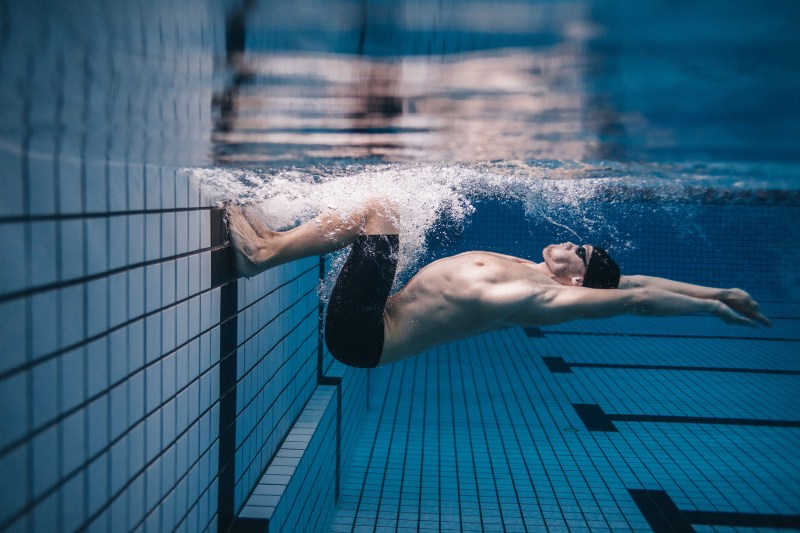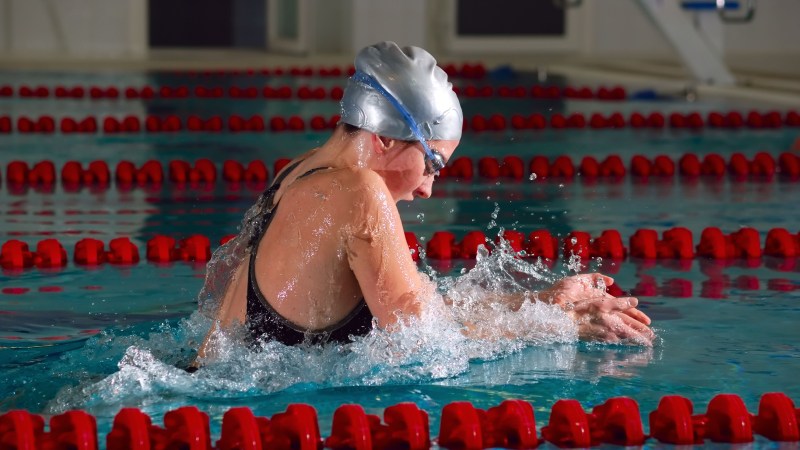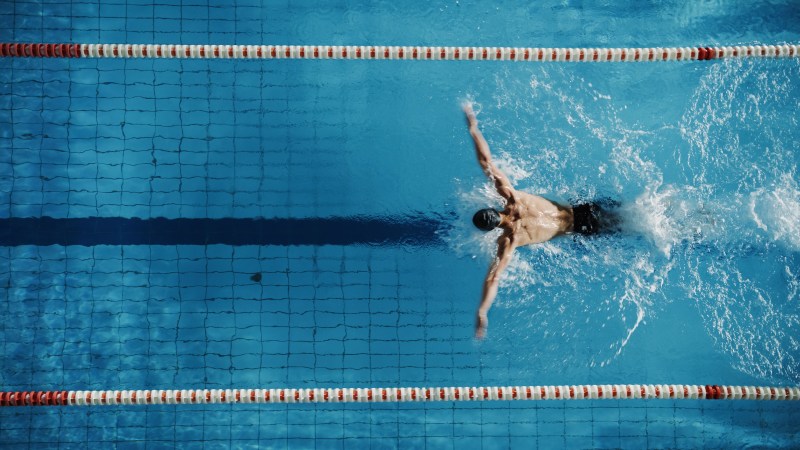
Each swimming technique offers a unique combination of muscle engagement and calorie burn, from the backstroke to the butterfly stroke. Whether you’re a fitness enthusiast, a competitive swimmer, or someone seeking a fun way to stay active, exploring these swimming strokes will open up a world of possibilities in the water. It’s time to flex those swimming muscles!
Read on to learn about the backstroke, breaststroke, butterfly stroke, and front crawl.

Characteristics of the backstroke
Without a doubt, the backstroke is an incredible whole-body workout. Not only does it work your chest and arms, but it also targets your glutes and core. And the best part? According to swimming.org, you can burn around 250 calories every 30 minutes you spend swimming the backstroke. Here are some key characteristics:
- Body Position: The swimmer lies on their back, with their face positioned out of the water. The body remains parallel to the water’s surface throughout the race.
- Arm Movement: Move your arms alternately in a windmill-like motion. One arm starts the stroke by reaching over the shoulder and entering the water pinky finger first. The arm then pulls down through the water in a semicircular motion, propelling the swimmer backward. The arm exits the water near the hip, and the other arm repeats the same movement.
- Leg Movement: The legs execute a flutter kick and should remain relatively straight to generate a consistent kicking motion below the water’s surface.
- Breathing: Taking breaths is far less complicated during the backstroke because the swimmer is already facing up. While performing a backstroke, breathe in as one arm passes your ear and out when the other arm passes the opposite ear.

Characteristics of the Breaststroke
The breaststroke is a favorite among swimmers for a good reason. It’s not only pretty but also a fantastic cardiovascular workout. When you swim the breaststroke, you engage and tone multiple muscle groups, including your abs, upper back, arms, and legs. Not only will you be sculpting those muscles, but you’ll also be torching calories like a champ. A 30-minute swim session can help you burn roughly 200 calories. Talk about a total-body tune-up! Here’s how it’s done:
- Body Position: The breaststroke begins facedown.
- Arm Movement: The arm movement happens in three steps: the catch, the pull, and the recovery. Extend your hands out in front of you, sweep your arms outward, and recover by tucking your elbows to extend your arms again for the next stroke.
- Leg Movement: Simultaneously with the arm movement, perform the leg action known as the “frog kick.” Bend your knees and bring your heels towards your glutes. Then, quickly extend your legs outward and backward in a circular motion, keeping your feet flexed.
- Breathing: Take a breath in as your arms extend forward and your head lifts slightly above the water. Exhale as you bring your head back down into the water.

Characteristics of the butterfly stroke
The butterfly stroke, often called the “queen of swimming,” is a captivating technique. With its powerful undulations and synchronized movements, the butterfly stroke showcases the perfect harmony of strength and grace in the water. It is a stroke that demands physical prowess and technical finesse, making it a favorite among competitive swimmers who are up for a challenge. Here’s the gist:
- Body Position: Start by positioning yourself with your face towards the water, with your arms extended forward and your legs close together.
- Arm Movement: When you’re ready, bring both arms out of the water simultaneously and sweep them forward over the water until they are fully extended in front of you. Then, dive your arms into the water and push them down beneath your body, bending your elbows.
- Leg Movement: As your arms begin the underwater phase, execute the dolphin kick with your legs. Keep your legs together and use a simultaneous motion to propel them downward and then upward in a wave-like motion. Imagine your legs as a dolphin’s tail, generating power and rhythm.
- Breathing: Timing is crucial for breathing in the butterfly stroke. After your arms have completed the underwater pull and are about to recover, lift your head slightly out of the water, quickly inhaling. As you bring your head back down, exhale forcefully.
When you take on the challenge of the butterfly stroke, you can expect to burn around 450 calories in just 30 minutes of swimming. The combination of intense arm pulls, dolphin kicks, and full-body engagement results in a calorie-blasting workout that will leave you feeling invigorated and accomplished.

Characteristics of freestyle swimming
The front crawl, also known as freestyle, is the epitome of efficiency in swimming. With its simple movements, the freestyle stroke has become the go-to choice for swimmers of all levels. Whether you’re a seasoned athlete or a recreational swimmer, freestyle offers a thrilling experience. Let’s dive into the front crawl:
- Body Position: Start by positioning yourself face down in the water. Keep your body as horizontal as possible, with your head aligned with your spine.
- Arm Movement: Begin by extending one arm forward, reaching as far as possible. Rotate your body slightly to that side as your arm enters the water. Pull your arm back through the water in a semicircular motion, propelling yourself forward. As your arm exits the water near your hip, the other arm repeats the same movement, alternating arms continuously.
- Leg Movement: Execute a flutter kick with your legs. Keep your legs relatively straight and kick from your hips alternatingly. Focus on a consistent and rhythmic kick just below the water’s surface.
- Breathing: Turn your head to the side to breathe while one arm is recovering above the water. Time your breath so that you inhale quickly and return your face to the water as your recovering arm enters.
In 30 minutes of swimming, you can burn up to 300 calories while toning your back muscles, stomach, backside, and shoulders. With its rhythmic and dynamic arm movements, alternating leg kicks, and smooth breathing technique, the freestyle stroke offers a full-body workout that improves cardiovascular fitness and enhances overall strength and endurance.
Overall, the world of swimming has much to offer. Each stroke has its unique benefits and characteristics. No matter which strokes you choose to learn. Next, swimming provides a refreshing and invigorating way to stay fit, improve your technique, and enjoy the wonders of the water. Happy swimming!



